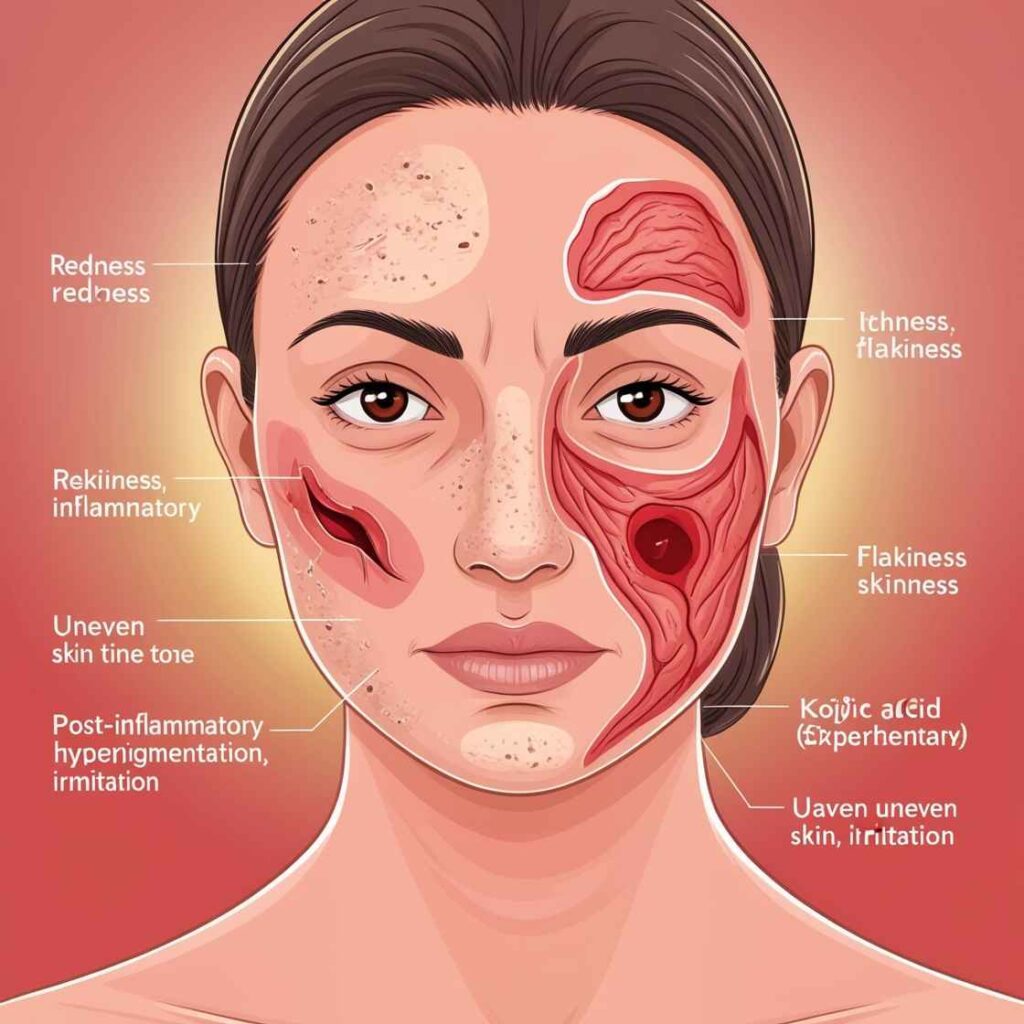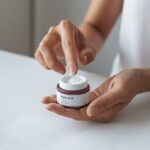- Contact dermatitis is a frequent side effect of kojic acid, causing redness, itching, and swelling
- Increased photosensitivity may result from kojic acid use, leading to a higher risk of sunburn and UV damage
- There is a potential carcinogenicity risk observed in animal studies. these findings are associated with high doses beyond cosmetic concentrations.
- Safe use of kojic acid involves sticking to concentrations below 1%
Kojic acid is a naturally occurring compound derived from fungi. It is commonly used in skincare for its skin-lightening properties. Kojic acid functions by inhibiting the enzyme tyrosinase, which is crucial in melanin synthesis. Commonly found in concentrations of 1% or less, kojic acid is utilized in creams, serums, soaps, and cleansers.
However, like many cosmetic ingredients, kojic acid has raised concerns regarding its safety. This article explores the documented side effects of kojic acid and provides evidence-based guidelines for safe usage.
Potential Side Effects of Kojic Acid

While kojic acid is effective, it’s not without risks. The following are the potential side effects, especially when it’s used in higher concentrations:
1. Contact Dermatitis
One of the most frequently reported side effects of kojic acid is contact dermatitis. This skin condition manifests as redness, irritation, itching, rashes, and swelling.
Why it happens:
Contact dermatitis occurs when the skin reacts negatively to an irritant or allergen. In this case, kojic acid acts as the irritant. Those with sensitive skin are especially prone to this reaction, and it’s more common with higher concentrations of kojic acid,above the recommended 1%.
What to watch for:
Signs of contact dermatitis appear within hours or a couple of days after using the product. Mild cases may involve a bit of redness or a slight rash, but severe reactions can lead to painful swelling or even blistering.
How to avoid it:
The best way to avoid contact dermatitis is to stick to products containing 1% or less of kojic acid. This concentration is widely considered safe for cosmetic use. Additionally, performing a patch test before fully committing to a new product can help you detect any potential allergic reaction early on.
Is Kojic Acid Safe for All Skin Types?
Dermatologist explains the risks and side effects of using kojic acid
@drora.official Reply to @mayeehh kojic acid is not bad but be careful as it has risks and side effects #kojicacid #kojicsoap #whitening #beautytips #skincaretip #fyp
2. Increased Photosensitivity
Kojic acid can also cause photosensitivity, making your skin more sensitive to sunlight.
How it happens:
Kojic acid inhibits melanin production, which not only lightens the skin but also reduces its natural protection against UV rays. While you’re lightening your dark spots, you’re also potentially increasing your risk of sunburn and UV damage.
If you continue to use kojic acid without protecting your skin from the sun, you’re at risk of developing more pigmentation issues, sunburn, and even premature aging. Over time, unprotected exposure to UV rays can lead to sunspots, wrinkles, and even skin cancer.
The Long-Term Effects of Using Kojic Acid: What You Should Know
Sun protection is key:
If you’re using products with kojic acid, it’s critical to pair them with a high-SPF sunscreen. Experts recommend at least SPF 30 or higher, and reapplying it throughout the day if you’re spending time outdoors. Wearing protective clothing like hats and sunglasses can further shield your skin from the sun’s harmful rays.
3. Potential Carcinogenicity
A more concerning yet less understood risk of kojic acid is its potential carcinogenicity (the possibility that it could contribute to cancer development)
What research says:
Some studies on animals have suggested that high doses of kojic acid might promote tumor growth. However, these results were observed when kojic acid was used at doses higher than what’s typically used in cosmetics. In fact, these doses were significantly higher than the 1% concentration recommended for skin products.
Human impact:
To date, there is no conclusive evidence that kojic acid causes cancer in humans. However, because of these findings in animal studies, regulatory bodies like the Cosmetic Ingredient Review (CIR) have emphasized that kojic acid should only be used at concentrations below 1% to minimize any potential risks.
What to consider:
While the cancer risk remains uncertain at cosmetic concentrations, it’s always wise to use any skincare product with caution. Monitoring how your skin reacts over time and limiting long-term, excessive use can help minimize concerns. If you’re ever in doubt, consulting with a dermatologist is a smart move.
4. Thyroid Effects
There’s some evidence suggesting that kojic acid, particularly when consumed orally in high doses, can have thyroid-related side effects.
Animal studies:
In experiments with animals, high doses of kojic acid led to an increase in thyroid size and alterations in hormone levels. This raises concerns about potential disruptions to the thyroid gland’s normal functioning.
Why it matters:
These side effects, however, are tied to oral ingestion, not topical application. The concentrations used in cosmetic products are much lower and applied to the skin rather than ingested, which reduces the risk of such side effects.
Staying safe:
It’s important to note that these thyroid-related issues don’t apply to topical skincare products containing 1% or less of kojic acid. Sticking to the recommended concentration and using the product as directed can help you avoid these complications altogether.
How to Use Kojic Acid Safely
Understanding the potential side effects of kojic acid is only half the battle. The key to getting the most out of this ingredient while minimizing risks lies in how you use it. Here are some expert-approved guidelines for safe usage:
Stick to Recommended Concentrations
The recommended concentration of kojic acid in skincare products is 1% or less. Anything higher increases your risk of side effects without adding significant benefits. If you’re unsure about the concentration of a product, check the label or ask a dermatologist for advice.
Perform a Patch Test
Before slathering a new product all over your face, perform a patch test. Apply a small amount of the product to an inconspicuous area, like your wrist or the side of your neck, and wait for 24 hours. If you notice any signs of irritation—redness, itching, or swelling—don’t use the product.
Limit Sun Exposure
Since kojic acid can increase your skin’s sensitivity to sunlight, it’s essential to use sunscreen with an SPF of at least 30 every day. This is especially important if you plan on being outdoors for extended periods. Wearing protective clothing, such as hats and long sleeves, can also reduce your risk of sunburn.
Avoid Using on Damaged Skin
Never apply kojic acid to broken, irritated, or damaged skin. Doing so can not only worsen irritation but also increase the chances of the acid penetrating too deeply, causing more harm than good.
Consult a Dermatologist
If you have sensitive skin, or if you’re unsure about whether kojic acid is right for you, it’s always a good idea to consult a dermatologist. They can help you determine whether kojic acid will benefit your skin and suggest safer alternatives if necessary.
Discussions on risks and side effects of using kojic acid
Here are some forums and discussions where users share their opinions, testimonials, and concerns regarding the use of kojic acid:
Acne.org Forum
- Reviewer: mommierenee
What they said: “Has anyone experienced breakouts from kojic acid soap? I purchased and used daily for maybe 3 weeks. My face was clear for the most part only a few breakouts here and there. But now I have very moderate/severe breakouts all along my jawline, chin, and forehead.” - Reviewer: John Taylor
What they said: “Kojic soap is a very harsh soap used to mainly whiten the skin! If you have sensitive skin do not use it.” - Reviewer: Jasonkingrz
What they said: “Kojic Acid soap has transformed my skincare routine, leaving my skin brighter, smoother, and more radiant than ever before.”
Nairaland Forum
- Reviewer: rofemiguwa
What they said: “I want to add kojic acid to the next batch I will make and I need advice as I don’t know if it will affect my skin.” - Reviewer: kalimera101
What they said: “Yes. Kojic acid does help in lightening the skin naturally… long term use is not advised.”
Reddit – SkincareAddiction
- Reviewer: Anonymous user
What they said: “It’s harsh and drying… I’ve been using kojie San Kojic soap for 10+ years. Cured my acne and keeps me from having future breakouts.” - Reviewer: Anonymous user
What they said: “I am also using Kojiesan Kojic soap. It helps dry pimple and fade pimple marks or dark spots.”
Skin Care Talk
- Reviewer: Anonymous user
What they said: “I would say those acids aggravate melanocytes much more and would quickly make the skin darker, when exposed to sunlight.”

I’m a devoted organic skincare enthusiast, passionate about the natural, wholesome goodness that organic products bring to our skin.
Organic skincare isn’t just a hobby for me—it’s a lifestyle. Every product I use, recommend, and write about has been carefully chosen for its purity and effectiveness. Everything I write about is backed by scientific studies, dermatologists’ opinions, and user experiences.
I also excel at tackling skincare challenges with innovative, organic solutions.


